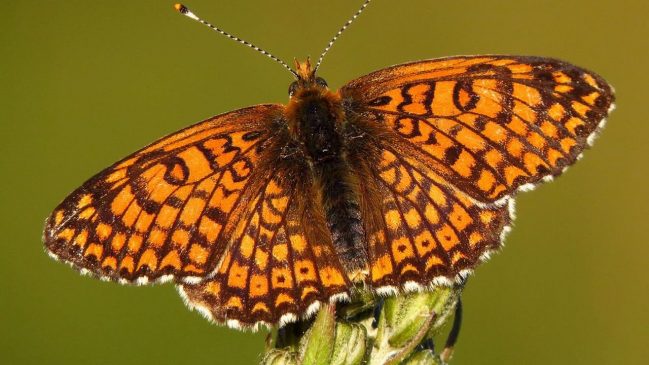The release of the butterfly brought four species to the island.

An ecologist’s blunder led to the release of a “Russian doll” set of stomach-bursting parasites onto a remote Finnish island, a new study has revealed.
Thirty years ago, when ecologist Ilkka Hanski introduced Glanville fritillary butterflies (Melitaea cinxia) onto the island of Sottunga in the Åland archipelago, he planned to watch how a population of one species that had been placed inside a harsh habitat could survive.
But he had no idea that a trio of nested parasites would come along for the ride — with two parasites living inside another parasite, which was itself nested inside some of the butterflies.
The latter parasites, the larvae of the parasitic wasps Hyposoter horticola, eat the Glanville caterpillars they are injected into from the inside out — erupting from their host’s abdomen to spin a cocoon around the caterpillar’s corpse, for pupation.
Two more species of parasites nest inside H. horticola. The second is a “hyperparasitoid”: parasitic wasps called Mesochorus cf. stigmaticus. The third species is a bacterium, Wolbachia pipientis, which makes H. horticola more susceptible to M. stigmaticus. If all three stowaways are aboard a caterpillar host, H. horticola kills the caterpillar before being killed by M. stigmaticus. The hyperparasite burrows out 10 days later — consuming its way through the bacteria-ridden flesh of the first wasp parasite and then the carcass of the caterpillar.
Yet somehow, 30 years after their introduction and in spite of multiple, significant population crashes among their butterfly hosts, all four species remain alive on the tiny, 10.4-square-mile (27 square kilometer) island. In a new study, published July 7 in the journal Molecular Biology, researchers analyzed the genetics of the H. horticola population and its bacterium to figure out how these parasites achieved this incredible feat.
Anne Duplouy, the lead author of the study, said that the butterflies’ fragile foothold on the island, and the numerous instances of their near-elimination from the habitat, is “a classic loss of biodiversity story.”
Glanville butterflies feed exclusively on two meadow plants as caterpillars, leaving the species vulnerable to sudden changes in its environment, said Duplouy, an evolutionary biologist at Lund University in Sweden. If these meadows are allowed to become overgrown, for instance, “bushes and trees take over and the host plants go extinct under tree covers,” she said. Glanville caterpillars are also strongly impacted by climatic events, such as drought, which can wake them too early from their diapause — the state of suspended animation some animal embryos enter to survive harsh conditions.
“If the drought occurs in the [fall], when the caterpillars wake up from their diapause, they will starve to death,” Duplouy told Live Science. “Because under a strong drought event, their host plant cannot grow and thus they have no food to feed on to reach the adult stage, the population will crash.”
Despite numerous near-extinction events, however, the butterflies have survived, and with remarkably high genetic diversity — owing to the high genetic diversity of the individuals that were first introduced to the island.
The parasites are surviving just as well as their butterfly hosts. Duplouy gives two reasons for their survival. Firstly, Sottunga’s butterfly population may be isolated from populations of its species elsewhere on the archipelago, but its wasp parasites are not. Both H. horticola and M. stigmaticus are superior flyers to the butterflies, with H. horticola in particular having an ability to surf on strong winds. Some gusts have even transported individual H. horticola wasps to previously uninhabited islands north of Sottunga, the researchers discovered in their surveys.
Secondly, the wasps — in particular H. horticola — have an incredibly efficient reproductive strategy.
“The butterfly lays its eggs in clutches of 50 to 200 eggs. And research suggests that the wasp can find every single one of these butterfly egg clutches in the field,” Duplouy said. “One parasitoid female will tour around the field and, daily, check the development of the butterfly eggs. When those are ready to hatch as larvae, the parasitoid lays its eggs inside the yet-intact butterfly eggshell. So as long as the butterfly is present, it is likely that the wasp will persist too.”
Hyperparasitoid M. stigmaticus wasps, which aren’t as good flyers as their H. horticola wasp hosts, are less well dispersed across the islands surrounding Sottunga and have resorted to inbreeding to survive, according to the researchers.
The accidental introduction of the parasites makes for a fascinating case study, but the researchers believe it also provides a clear warning about the need to understand both endangered species and the species associated with them before any attempt is made to restore any of them to a new environment. The parasitoid wasps, for example, are commonly deployed as pest control in agriculture, so they are relatively well understood by humans, but a more elusive species could have wreaked havoc upon the new environment.
Despite the amazing survival of the butterflies and their parasitoids so far, Duplouy said that population crashes — caused by sudden drought — are likely to become worse as the effects of climate change become more intense.
“We are worried for the Sottunga populations, for the butterfly and its parasitoids. The last few years, drought events have been more regular, and the population crashes across Åland are stronger,” she said. “The population in the south of Sottunga, in Föglö, has gone extinct a couple of years ago, and Sottunga has been a very, very small population for many years now, we fear we might see the end of it very soon. It would be a shame to lose it after 30 years of persistence.”
